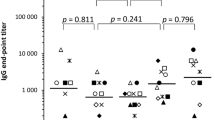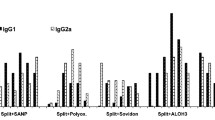Summary
The protective effects of passively administered antibodies against hantavirus infection were studied in newborn rats. Death as well as infection were completely prevented from intraperitoneal challenge of strain SR-11 (SR) (2×103 FFU, 102.1 LD50), in newborn rats which received 0.1 ml of anti-SR rat serum (neutralizing antibody titer, 1:640) 4hr before the virus challenge. In these rats, no virus was detected in the peritoneal macrophages, lung, kidney, and brain. The immune serum infusion before the virus challenge also conferred protection to rats against an intramuscular or subcutaneous challenge of strain SR, but did not protect the rats against intracerebral challenge of the virus. In the rats which received the immune serum after the challenge, infection was not prevented, although some of the animals were protected from the death. Virus titers in the lung, kidney, and brain of the rats were reduced by the transfer of the immune serum even as late as 72hr after the challenge. Cross-protection in the rats which received the immune serum was strong between strains SR and KI-262 within the same serotype, but very weak between strains SR and Hantaan 76–118 of different serotypes.
Similar content being viewed by others
References
Adinolfi M, Beck SE, Haddad SA, Seller MJ (1976) Permeability of the blood-cerebrospinal fluid barrier to plasma proteins during foetal and perinatal life. Nature 259: 140–142
Arikawa J, Takashima I, Hashimato N, Takahashi K, Yagi K, Hattori K (1986) Epidemiological studies of hemorrhagic fever with renal syndrome (HFRS) related virus infection among urban rats in Hokkaido, Japan. Arch Virol 88: 231–240
Asada H, Tamura M, Kondo K, Okuno Y, Takahashi Y, Dohi Y, Nagai T, Kurata T, Yamanishi K (1987) Role of T lymphocyte subsets in protection and recovery from Hantaan virus infection in mice. J Gen Virol 68: 1961–1969
Brummer-Korvenkontio M, Vaheri A, Hovi T, von Bonsdorff C-H, Vuorimies J, Manni T, Penttinen K, Oker-Blom N, Lahdevirta J (1980) Nephropathia epidemica: detection of antigen in bank voles and serologic diagnosis of human infection. J Infect Dis 141: 131–134
Chumakov MP, Gavrilovskaya IN, Boiko VA, Zakharova MA, Myasnikov Yu A, Bashkirev TA, Apekina NS, Safiullin RS, Potapov VS (1981) Detection of hemorrhagic fever with renal syndrome (HFRS) virus in the lungs of bank volesClethrionomys glareolus and redbacked volesClethrionomys rutilus trapped in HFRS foci in the European part of U.S.S.R., and serodiagnosis of this infection in man. Arch Virol 69: 295–300
Dantas JR, Jr, Okuno Y, Tanishita O, Takahashi Y, Takahashi M, Kurata T, Lee HW, Yamanishi K (1987) Viruses of hemorrhagic fever with renal syndrome (HFRS) grouped by immunoprecipitation and hemagglutination inhibition. Intervirology 27: 161–165
Desmyter J, LeDuc JW, Johnson KM, Brasseur F, Deckers C, van Ypersele de Strihon C (1983) Laboratory rat associated outbreak of hemorrhagic fever with renal syndrome due to Hantaan-like virus in Belgium. Lancet 2: 1445–1448
Kitamura T, Morita C, Komatsu T, Sugiyama K, Arikawa J, Shiga S, Takeda H, Akao Y, Imaizumi K, Oya A, Hashimoto N, Urasawa S (1983) Isolation of virus causing hemorrhagic fever with renal syndrome (HFRS) through a cell culture system. Japan J Med Sci Biol 36: 17–25
Lee HW, Baek LJ, Johnson KM (1982) Isolation of Hantaan virus, the etiologic agent of Korean hemorrhagic fever, from wild urban rats. J Infect Dis 146: 638–644
Lee HW, Lee PW, Baek LJ, Song CK, Seong IW (1981) Intraspecific transmission of Hantaan virus, etiologic agent of Korean hemorrhagic fever, in the rodentApodemus agrarius. Am J Trop Med Hyg 30: 1106–1112
Lee HW, Lee PW, Johnson KM (1978) Isolation of the etiologic agent of Korean hemorrhagic fever. J Infect Dis 137: 298–308
Lee PW, Amyx HL, Yanagihara R, Gajdusek DC, Goldgaber D, Gibbs CJ Jr (1985) Partial characterization of Prospect Hill virus isolated from meadow voles in the United States. J Infect Dis 152: 826–829
Lee PW, Gibbs CJ Jr, Gajdusek DC, Yanagihara R (1985) Serotypic classification of Hantaviruses by indirect immunofluorescent antibody and plaque reduction neutralization tests. J Clin Microbiol 22: 940–944
Lloyd G, Bowen ETW, Jones N, Pendry A (1984) HFRS outbreak associated with laboratory rats in UK. Lancet 1: 1175–1176
Morita C, Morikawa S, Iida A, Ogata M, Sugiyama K, Kitamura T (1986) Protective role of passive administration of antibody against HFRS. JE HFRS Bull WHO 1: 69
Nagai T, Tanishita O, Takahashi Y, Yamanouchi T, Domae K, Kondo K, Dantas JR, Jr, Takahashi M, Yamanishi K (1985) Isolation of haemorrhagic fever with renal syndrome virus from leukocytes of rats and virus replication in cultures of rat and human macrophages. J Gen Virol 66: 1271–1278
Schmaljohn CS, Hasty SE, Dalrymple JM, LeDuc JW, Lee HW, von Bonsdorff C-H, Brummer-Korvenkontio M, Vaheri A, Tsai TF, Regnery HL, Goldgaber D, Lee PW (1985) Antigenic and genenic properties of viruses linked to hemorrhagic fever with renal syndrome. Science 227: 1041–1044
Song G, Hang C-S, Qui X-Z, Ni D-S, Liao H-X, Gao G-Z, Du Y-L, Xu J-K, Wu Y-S, Zhao J-N, Kong B-X, Wang Z-S, Zhang Z-Q, Shen H-K, Zhou N (1983) Etiologic studies of epidemic hemorrhagic fever (hemorrhagic fever with renal syndrome). J Infect Dis 147: 654–659
Sugiyama K, Morikawa S, Matsuura Y, Tkachenko EA, Morita C, Komatsu T, Akao Y, Kitamura T (1987) Four serotypes of haemorrhagic fever with renal syndrome viruses identified by polyclonal and monoclonal antibodies. J Gen Virol 68: 979–987
Tanishita O, Takahashi Y, Okuno Y, Tamura M, Asada H, Dantas JR, Jr, Yamanouchi T, Domae K, Kurata T, Yamanishi K (1986) Persistent infection of rats with haemorrhagic fever with renal syndrome virus and their antibody responses. J Gen Virol 67: 2819–2824
Tanishita O, Takahashi Y, Okuno Y, Yamanishi K, Takahashi M (1984) Evaluation of focus reduction neutralization test with peroxidase-antiperoxidase staining technique for hemorrhagic fever with renal syndrome virus. J Clin Microbiol 20: 1213–1215
World Health Organization (1983) Haemorrhagic fever with renal syndrome: memorandum from a WHO meeting. Bull WHO 61: 269–275
Yanagihara R, Amyx HL, Gajdusek DC (1985) Experimental infection with Puumala virus, the etiologic agent of nephropathia epidemica, in bank voles (Clethrionomys glareolus). J Virol 55: 34–38
Zhang X-K, Takashima I, Hashimoto N (1988) Role of maternal antibody in protection from hemorrhagic fever with renal syndrome virus infection in rats. Arch Virol 103: 253–265
Zhang X-K, Takashima I, Mori F, Hashimoto N (1989) Comparison of virulence between two strains ofRattus serotype hemorrhagic fever with renal syndrome (HFRS) virus in newborn rats. Microbiol Immunol 33: 195–205
Author information
Authors and Affiliations
Rights and permissions
About this article
Cite this article
Zhang, XK., Takashima, I. & Hashimoto, N. Characteristics of passive immunity against hantavirus infection in rats. Archives of Virology 105, 235–246 (1989). https://doi.org/10.1007/BF01311360
Received:
Accepted:
Issue Date:
DOI: https://doi.org/10.1007/BF01311360




